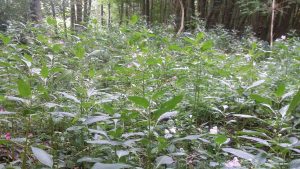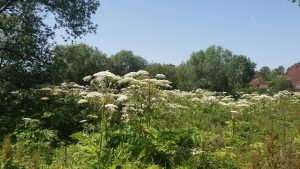Protect Your Project with Invasive Weed Training

In the fast-paced world of construction, unexpected delays can have significant consequences. One often overlooked issue that can halt a project is the presence of invasive plant species. From Japanese knotweed to Giant hogweed, these plants not only disrupt the environment but can also lead to project delays and compliance issues – even health risks!
The Risks Posed by Invasive Plants
Invasive plants like Japanese knotweed are notorious for their aggressive growth and ability to cause structural damage. They can exploit weaknesses in buildings, foundations, and infrastructure, leading to costly repairs. The rhizomes of Japanese knotweed, for example, grow through small cracks in concrete and tarmac, worsening structural vulnerabilities.
The risks extend beyond physical damage. Under UK law, it is illegal to cause the spread of certain invasive species. Failing to manage them properly can result in legal action and fines, meaning construction companies must adhere to strict environmental regulations – potentially causing project delays.
certain invasive species. Failing to manage them properly can result in legal action and fines, meaning construction companies must adhere to strict environmental regulations – potentially causing project delays.
The Role of Training in Preventing Delays
The best way to minimise the risks posed by invasive species is early identification. This is where workforce training becomes crucial. By equipping teams with the knowledge to spot common invasive plants, delays can be prevented. Identifying Japanese knotweed early, for instance, enables teams to act swiftly, calling in specialists before the plant spreads further.
Trained employees also understand the steps to take when they encounter these species. Instead of costly project halts while experts are brought in, workers can follow protocols, reducing downtime and ensuring clients receive the right advice. A proactive approach is always more effective than dealing with an unchecked infestation.
The Benefits of Professional Training
Investing in professional training for your workforce can save time and money. It ensures your team can identify species like Japanese knotweed or Giant hogweed early, preventing delays in construction schedules. Moreover, trained staff are aware of legal obligations surrounding invasive species, reducing the risk of compliance issues and potential fines.
delays in construction schedules. Moreover, trained staff are aware of legal obligations surrounding invasive species, reducing the risk of compliance issues and potential fines.
Professional training also helps workers adopt a proactive approach, identifying potential problems early and taking preventative measures. This keeps projects on track, avoiding disruptions caused by unmanaged invasive species.
What to Look for in a Training Provider
When selecting a training provider for invasive plant identification, choose one with experience in both the construction and environmental sectors. A quality programme should cover the identification of common invasive species, do’s and don’ts, biosecurity measures and legal regulations that apply in the UK.
Look for providers offering practical, hands-on training. Real-world examples, visual aids, and site visits ensure workers feel confident in identifying invasive plants on-site. The training should also guide the team on the next steps after identifying invasive species, such as proper reporting and containment measures.
A well-trained workforce can identify invasive species early on, calling in invasive weed removal experts at the right time to help projects to stay on course.
0333 2414 413

